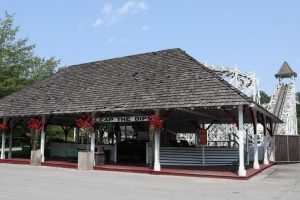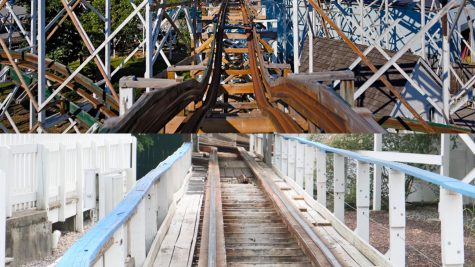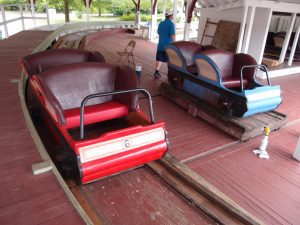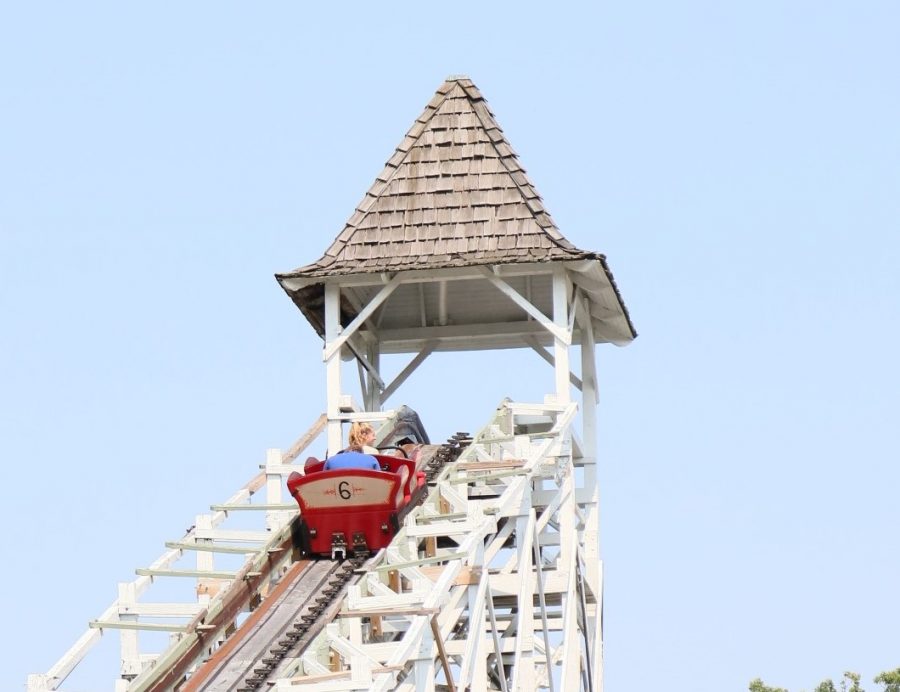119 Years and Rolling
The world’s oldest roller coaster is right here in Pennsylvania.
The cupola on the lift hill of Lakemont Park’s Leap the Dips evokes an earlier time.
October 20, 2021
Western Pennsylvania is home to what is perhaps the greatest collection of historic amusement parks in the world. With six existing amusement parks dating from before 1900 and many distinctive old rides, the region has no shortage of amusement park history.
Pennsylvania is also the best state in the nation for classic wooden roller coasters. The state is home to 19 wooden coasters, more than two times the number found in any other state.
With such a heritage, it should be no surprise that the world’s oldest operating roller coaster is found in in our home state. Altoona’s Lakemont Park has had a difficult history, but one key ride remains from the park’s earliest days: Leap the Dips. Built in 1902, the world’s oldest roller coaster has a character all its own.

As soon as you board the car, you immediately realize that this is a coaster from a different era. There are no seatbelts, and the only restraint is a stationary grab bar. With gentle drops, you may think that this will be a tame ride, but in reality, Leap the Dips will throw you about seat like a rag doll.
The primitive technology of Leap the Dips is evident as the car is shoved out of the station by the operator and begins to climb the lift hill. During the ascent, wooden boards hit the sides of the car to keep it from rolling back. As a result, instead of the memorable clicking sound found on most coasters, you hear a steady “thunk” as you rise up the hill.
Once over the crest, the ride follows a predictable pattern, winding down three tiers of track with small dips between levels. The size of the drops can be deceiving, though, as the car jostles up and down in its trough-like track, bouncing riders out of their seats. For an even wilder ride, sit in the back row. Sliding into the brakes (operated manually with a simple lever), it’s clear that, at 119 years old, Leap the Dips is not only a charming antiquev — it can also be a load of fun.
Leap the Dips is the lone survivor of a mass-produced coaster design known as a Figure Eight. A must-have ride for small parks at the turn of the 1900s, there were more than 300 identical Figure Eight coasters across the country during their peak. Practically every amusement park in America had one at that time — including Pittsburgh-favorite Kennywood. Yet by 1950, fewer than 20 remained.

The demise of the Figure Eight coasters owed to new roller coaster technology, which allowed for faster speeds and arguably greater thrills. Prior to 1920, all coasters like Leap the Dips were built using “side-friction” technology, which employs a track with high sides to guide the car’s path. The significant difference in this old design is that side-friction coasters do not have wheels beneath the track (see image to right). The car can thus actually lift off the track when cresting a hill with extra speed; as such, the sizes of drops are limited in the interest of safety.
The introduction of wheels underneath the coaster track made side-friction roller coasters like the Figure Eight obsolete. Underfriction wheels, as they are called, were first used in 1920 on several coasters, including Kennywood’s Jack Rabbit. The technology paved the way for an era of 1920s rides that is known as the “Golden Age” of wooden coasters. And for anyone who has been pushed to their limits on the Jack Rabbit’s shocking double-dip, it’s clear why the public was no longer excited by the quaint Figure Eight coaster. (In fact, the year after the revolutionary Jack Rabbit opened, Kennywood’s quaint Figure Eight was removed.)
Despite being an anachronism, however, Lakemont Park’s Leap the Dips survived, if only barely, eventually becoming the only side-friction coaster left in America. Unfortunately, after operating quietly for decades, Lakemont Park was sold to new operators in 1985, and Leap the Dips was closed.

Lakemont Park struggled to survive in the years since 1985, but luckily, Leap the Dips was not demolished, instead falling into increasing disrepair. By the 1990s, the fate of the world’s oldest roller coaster was in question. Some believed that Leap the Dips was beyond repair, but the American Coaster Enthusiasts were able to raise funds for its restoration, and the ride reopened to much fanfare in 1999.
Since then, Lakemont Park has continued to remain on shaky footing, and the park was recently closed for three years to change its business model, which meant removing the majority of the park’s rides -with the exception of the roller coasters – to create a public park atmosphere. Even so, Leap the Dips holds a central place at Lakemont Park today, promising to gently thrill riders for years to come.
Though the drive is over two hours from Pittsburgh, it is worth a stop in Altoona to experience the world’s oldest roller coaster. Leap the Dips is a fascinating time capsule, a throwback to amusement parks of the past. Once commonplace, the coaster is now a sole survivor, and its operation remains true to the original 1902 design. Though the history of amusement parks is often forgotten, this coaster is a prime example of how classic rides can often be just as enjoyable as today’s high-tech thrillers.












